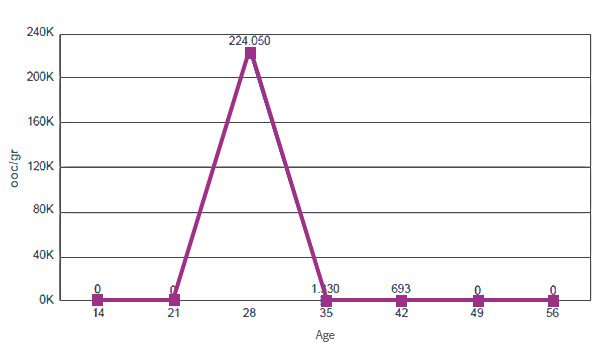What’s the efficacy of the Coccidiosis prevention methods I’m using? This in one of the main questions that arises when working on control strategies against Coccidiosis in poultry. In addition to classic techniques (like evaluation of intestinal lesions), counting the oocysts of Eimeria spp. excreted in the faeces has been shown to be a very useful tool. It can be a complement to the diagnosis of the disease and also help us to check if birds have acquired immunity against the parasite.
 Figure 1: Excretion pattern of oocysts during a coccidiosis outbreak
Figure 1: Excretion pattern of oocysts during a coccidiosis outbreak
In order to determine the health status of a farm and to evaluate the efficacy of the protective measures that are being taken against Eimeria spp. parasites, the use of appropriate diagnostic techniques is essential.
Unfortunately, the methods commonly used with other diseases (serology in particular) are not applicable in the case of coccidiosis, because of its particular life cycle.
This is why one of the most widely used methods in the field for this evaluation is to count the oocysts excreted by the birds (oocysts per gram or OPG).
This count enables us to identify in a simple way the quantity of Eimeria spp. oocysts (both field strains and those from live vaccines) excreted on a farm, in a shed or by a group of animals.
Although this technique has to be supplemented by others for a complete diagnosis (evaluation of lesions / morphology / PCR ), it provides us with valuable information if we know what samples to take at a particular time and how to interpret the results.
The key to this technique lies in monitoring consecutive samples of faeces excreted by the birds or of litter material.
The normal progression shown by this monitoring will take the form of a Gaussian bell curve, with an initial growth in the number of oocysts, a maximum peak of excretion and then a gradual decrease.
Eimeria spp. oocysts in a coccidiosis outbreak
In the case of development of field strains, the peak of excretion of oocysts of the different Eimeria species usually occurs when the birds are around 28 days old.
This is when the maximum point of replication in the intestinal tract has been reached.
After the peak, the number of oocysts excreted in the faeces and found in the bedding material will reduce as a result of the development of specific immunity against the parasites.
This will prevent the cycle of Eimeria spp. developing and as a consequence, this trend will be seen in the curve of the oocyst count.
In the case of a disease outbreak caused by these field strains, the infestation will have been overcome, but leaving clinical signs, mortality and/or losses in productive parameters in its wake.
In order to avoid this situation, farmers and veterinarians have a range of preventive or therapeutic techniques at their disposal.
Despite the fact that the use of anticoccidials is the most widely used system, new trends in poultry production show an ever greater use of live attenuated vaccines for the preventive control of coccidiosis.
Eimeria spp. oocysts of vaccine strains
Vaccines against coccidiosis that are attenuated for precociousness not only provide early immunisation of the animals against the disease, but their effect can also be evaluated by the oocyst count.
The Eimeria spp. strains in these vaccines, by their nature, will replicate more quickly than the parent strains, achieving an earlier peak of excretion of vaccine oocysts.
This will occur if the vaccine is administered in the birds’ first few days of life and in appropriate conditions for the development of vaccine oocysts.
Another quality that can be observed in these selected oocysts of Eimeria spp. is their limited capacity for replication compared to non-attenuated strains.
This means that the quantity of oocysts in the replication peak of the vaccine strain will be smaller than in the peak generated by the field strains and that this replication will not cause clinical outbreaks of coccidiosis.
The following video explains the process of attenuation of vaccine strains by precociousness:
If the management of the vaccine and of the farm has been appropriate, the peak that is associated with an outbreak of coccidiosis around 28 days of life will be reduced or will disappear, giving a curve with a lower excretion peak of Eimeria oocysts (less replication) that is shifted to earlier dates (21 or even 14 days of life).
This would be the ideal scenario in the use of a vaccine attenuated for precociousness, indicating a good development of immunity against coccidiosis, which will prevent the development of Eimeria spp. and therefore an outbreak of the disease.
Nevertheless, the shape and development of this curve will depend on several factors (correct vaccination, conditions for replication of the vaccine oocysts in the litter material, traces of substances that are harmful to the vaccine oocysts in the feed and/or water, infection pressure, etc.).
Each curve must be evaluated by an expert with knowledge of this diagnostic tool, and its significance must be supplemented by further investigations.
This will make it a very useful tool for identifying the situation of a farm with regard to coccidiosis.
REFERENCES:
- Jeffers T.K. (1975). Attenuation of Eimeria tenella through selection for precociousness. J Parasitol. Dec; 61(6):1083-90.



